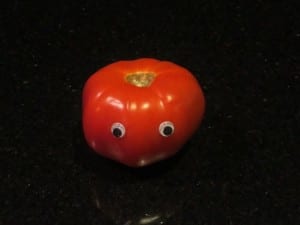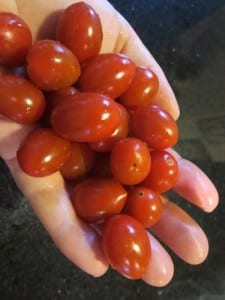The following interview took place one morning with a particularly, ripe and alert tomato. We will try to get some juicy details from one of our favorite spring-summer offerings.
Please, for the record, state your name.
My name is Big Beef, but I would like to speak on behalf of all tomatoes in various shapes, sizes, and varieties.
(Here’s me!)
Well, you are a wonderful specimen, and thank you for your time in advance. I’d like to just dive in and ask you to answer the controversial question that’s been plaguing you for years….Are you a vegetable or a fruit?
Scientifically, I am a fruit. It is because of the fact that I am usually used in savory culinary purposes that I have been considered a vegetable. I am a lovely fruit that, I must say, is sometimes overlooked as a delectable, stand alone meal. I mean, some people miss out on the delicious flavor of a tomato freshly picked from the sun-warmed vine. Sometimes a little sprinkling of salt and pepper added to a tomato are the only things that need be desired. And cherry/grape tomatoes are so sweet they can be popped into the mouth and eaten like grapes.
(Tiny, grape tomatoes held like a handful of M&M’s…but better for you!)
Well, I must say, that does all sound delicious so far. But tell me, would you say tomatoes work well with others?
Do they work well with others? I have to say, without trying to sound too conceited, that they most certainly work well with others. Just tossing them in with basil, garlic, and olive oil can give you a quick appetizer worthy of rave reviews (Bruschetta sans tomatoes? I scoff to think of it.). Dicing them up and pairing them with some jalepenos, onions and cilantro will add some spice in your life (Salsa without tomatoes? Aye, Aye, Aye, don’t think so.). How about simmering them down to a delectable sauce for an Italian-inspired supper that will warm your heart (Mama Leoni’s spaghetti sauce with no tomatoes? Che orrore!). And that’s just the start of their list of accomplishments, uh, I mean their proof of working well with others.
(Me and my bud, Jal!)
Hmm, let’s move on to your upbringing. Would you consider yourself determinate or indeterminate in your way of growing?
Well, being a Big Beef, I grew up on an indeterminate vine, which basically means that there wasn’t a specific time frame in which all of my family was produced. My indeterminate vine grew really large (6 feet usually and sometimes up to 10) and always needed to be supported by a cage or some large stakes; but there were always flowers being set and fruit being produced, so it was a lot of fun growing up with so many tomatoes around. And we would keep growing and producing until frost would would roll around or until our owners neglected us. We had a nice, large garden area because we weren’t allowed to live in pots due to our vine size. I had friends who were of the determinate variety, or bush variety, and they were able to live in the pots and containers (5-7 gallon minimum) because they didn’t get quite as unruly as we did. They grow only to about 3-4 feet tall. We would only have them around for a certain amount of time though, because their plant would grow all their fruit in a short period of time (usually 2-3 weeks) and then their plant would start to diminish.
(A large, mature, indeterminate vine.)
Could you name some of the friends you’ve known in indeterminate families and some from determinate families?
Sure, as far as indeterminate tomatoes go, some that stick out in my head are: Better Boy, Early Girl, most “cherry” types, and most heirlooms, just for a start. As far as determinate go, there are BHN444, BHN 602, Patio, Bobcat, and Solar Fire, just for a few examples. But this is just scratching the surface. Here’s a list I can give you that explains more about each variety. Hybrid Tomato Varieties and if you are interested in heirloom varieties, click here Heirloom Tomato Varieties.
What do you yearn for? And what do you wish people would know more about you?
Start me off right, and I will work my hardest for you. Give me the best possible beginning by filling my garden bed with lots of compost and yummy organic fertilizers to feed the healthy microbes in the soil. Microbes break down organic material and process it into a form that can be taken up by all plants. Rock phosphate rocks my world! If you could add a cup to the bottom of each planting hole, it would be one of the most important amendments you could offer my soil. I like to be set deep when planted, and I like to be watered deeply, but watch that it’s not too often. I appreciate Epsom salt sprinkled around my soil because it helps replace the calcium deficiency I get from being watered with the water from our hoses, it also helps me avoid blossom end rot (when I get that big round spot on my underside. So embarrassing!) Oh, and to feel the sunlight on my outstretched leaves. I think it is known, but maybe not to the degree, how much I need the sunlight to grow correctly. I need it for photosynthesis, and to dry out between rain spells and watering. Give me 10 hours out of the shadows and I am happy. And lastly, I love company! I will always welcome your presence, so visit me and visit me often.
(Ahhhh. Epsom salt!)
What are your fears?
Some of this might sound similar to my list above, but I can explain why. I fear the dark. Not giving me enough light not only stunts my growth, but it invites many other types of problems: like leaf blight, and other fungus to come visit me. Another fear is drowning. While I love a long drink of water, I need to have my watering spaced out. give me a little time to recover. Can you imagine drinking a tall glass of water and getting satiated, only to have one come every 5 minutes for 24 hours? Enough is enough! Also while you are at it, mulch me please. If you do, you will conserve on water and help me avoid that first leaf blight fear that I also get from water splashing up on my leaves. Spider mites, hornworms, leaf miners, and other creepy crawlies, I just get the heebie jeebies thinking of them. Best bet is to get on a preventative schedule to keep the pests at bay, and keep them there! Organic products containing ingredients like seaweed and molasses can do wonders, or a flip flop schedule of pyrethrin and spinosad could keep me pest free throughout the season. I also fear broken limbs. Never met a being who enjoyed that happening to them. I don’t mind being put in a cage, because I get heavy on my vine and need the support so I don’t end up tearing a limb and rotting on the ground. And lastly, I have the fear of abandonment. Check on me often, things in the garden can change daily so if you forget about me for week, something might have happened to me and it might be too late to fix by then.
(Yikes! Prevent these with a maintenance schedule. You can pluck them off too, if you visit me often. )
Well, we want to thank you for your time and your candor. So do you have any last rites? Uh, I mean words?
(Nervously looking around) I enjoyed sharing the information with you and I look forward to our next interview.
Yeah, that’s not gonna happen.
The Happy Gardener
Lisa Mulroy








Loved this “tomato conversation”. It was very informative. I jotted down the suggested planting ideas. Looking forward to a magnificent tomato season
It’s starting now! We have some great selections at both of our locations. Best of luck and let us know what we can do to help.
MY tomatoes are struggling.I am watering, using pesticides, and now shading with 40% light. Looks like blight, but bthe top of plant looks healthy. I need help. containter planting, because soil sucks here. (from socal).
To address your concern on blight, it does start at the bottom and creeps its way up. Early treatment is essential, so you can look at getting Bondide Liquid Copper Fungicide (organic) or Daconil fungicide (synthetic, but safe for veggies), and check out this blog for more info on blight. It has some great tips for preventing it from happening in the first place. I’m wondering what type of tomatoes you have purchased. If you are experiencing high temperatures, many larger fruiting tomatoes shut down in summertime and don’t produce, and get hard-to-control disease issues, so sometimes it’s not worth trying to get them through the end of the season. We are based out of San Antonio, Texas where we have two growing seasons so we plant very early in spring and harvest early summer and then pull plants out and start again in early fall. I am not very familiar with the growing season(s) of southern California. But if you have multiple chances at growing veggies, and the plant is struggling so much, you might want to start over. (Sanitize pot if plating in it again, 9-1 water to bleach ratio)
I’d be interested in knowing what variety you have, and when you planted them, and if they currently have fruit or had fruit at all yet, and if so, how close they look to being harvested?
There are some amazing landscapes here in TX. That being said, you do with what you have. If you have ‘sucky’ soil, start amending it with compost, leaves, woodchips, etc.. There are several YouTube videos from gardeners here in TX that show you how to do it. I’m sure Rainbow Gardens offers classes on how to amend your clay soil. Also, I’ve learned tons by just experimenting. Not all works out, but then you learn from your mistakes and look for other options that do work. My backyard is clay soil, but after 2 years of compost layering (lasagna gardening), I’ve managed to work a small plot on the ground where I will be able to grow something. Anything is possible with a little elbow grease. Good luck. (Former transplant from MT. (Zone 3a and on my 14th year of loving Texas :))